Recent Posts
Top 5 Causes of Water Damage and How to Prevent Them This Winter
1/28/2025 (Permalink)
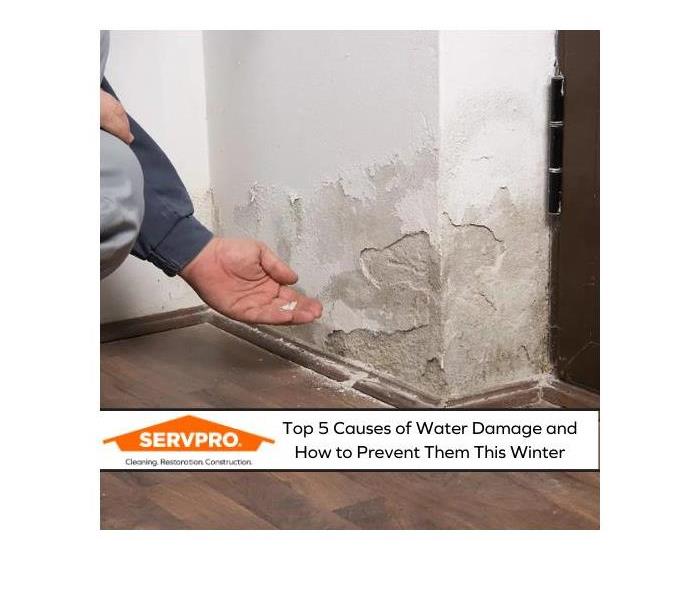 Top 5 Causes of Water Damage and How to Prevent Them This Winter
Top 5 Causes of Water Damage and How to Prevent Them This Winter
Winter is a season of cozy evenings and holiday cheer, but it’s also when homes and businesses are at greater risk for water damage. The combination of freezing temperatures, heavy precipitation, and potential maintenance oversights can lead to costly repairs and disruptions. At SERVPRO of East Greenville County, we understand the importance of protecting your property during the colder months. Here, we explore the top five causes of water damage in winter and provide practical tips to prevent them.
1. Frozen and Burst Pipes
One of the most common causes of winter water damage is frozen pipes. When temperatures plummet, the water inside pipes can freeze, expand, and cause the pipe to burst. This can lead to significant water damage within minutes.
Prevention Tips:
- Insulate Pipes: Use pipe insulation or heat tape to protect pipes in unheated areas like basements, crawl spaces, and attics.
- Keep a Consistent Temperature: Maintain a steady indoor temperature of at least 55°F, even if you’re away.
- Let Faucets Drip: During extreme cold, allowing a small trickle of water to flow through faucets can prevent freezing.
- Seal Drafts: Check for drafts near pipes and seal any gaps in windows, doors, or walls to keep the cold out.
2. Ice Dams
Ice dams form when heat from your home’s attic melts snow on the roof. The melted water flows to the edge of the roof and refreezes, creating a barrier that prevents proper drainage. This trapped water can seep into your home and cause damage to walls, ceilings, and insulation.
Prevention Tips:
- Improve Attic Insulation: Proper insulation prevents heat from escaping, which can help reduce ice dam formation.
- Clear Gutters: Ensure gutters and downspouts are free of debris to allow melted snow to drain away.
- Use a Roof Rake: After a heavy snowfall, use a roof rake to remove snow from the edges of your roof.
- Ventilate the Attic: Good ventilation keeps the attic cool and reduces the chance of snow melting unevenly.
3. Heavy Snowfall and Roof Leaks
Snow accumulation on roofs can lead to structural stress and leaks, especially if the roof is already weakened or poorly maintained. When snow begins to melt, the water can seep through cracks and cause damage inside your property.
Prevention Tips:
- Inspect Your Roof: Check for damaged shingles, loose flashing, or other vulnerabilities before winter starts.
- Clear Snow Safely: Use professional snow removal services or proper tools to avoid damaging the roof.
- Ensure Proper Drainage: Verify that gutters and downspouts are directing water away from the foundation.
4. Faulty Heating Systems
Malfunctioning or outdated heating systems can contribute to water damage in two ways: leaks from boilers or radiators and improper humidity levels causing condensation. Either issue can result in water pooling where it shouldn’t.
Prevention Tips:
- Schedule Maintenance: Have your heating system inspected and serviced annually by a qualified professional.
- Check for Leaks: Regularly inspect radiators, boilers, and HVAC systems for any signs of leakage.
- Control Indoor Humidity: Use a dehumidifier to maintain optimal humidity levels and prevent condensation buildup.
5. Basement Flooding
Winter storms, rapid snowmelt, or poor drainage can lead to water seeping into your basement. Cracks in the foundation or clogged sump pumps can exacerbate the problem.
Prevention Tips:
- Seal Foundation Cracks: Inspect your foundation for cracks and use sealant to prevent water infiltration.
- Maintain Sump Pumps: Test your sump pump regularly to ensure it’s functioning properly.
- Grade the Landscape: Ensure the ground slopes away from your home’s foundation to direct water away.
- Install Window Well Covers: These covers can keep snow and ice from accumulating around basement windows.
Why Timely Action is Crucial
Water damage doesn’t just disrupt your daily life; it can also lead to long-term issues like mold growth, weakened structural integrity, and costly repairs. Quick action can prevent a minor issue from becoming a major problem. SERVPRO of East Greenville County specializes in water damage restoration, providing expert services to help you recover quickly.
How SERVPRO Can Help
At SERVPRO of East Greenville County, we offer comprehensive water damage restoration services tailored to your needs. From initial assessment and water extraction to drying and repairs, our team is equipped to handle it all. With 24/7 emergency services, we’re always here to help when you need us most.
Our Services Include:
- Water extraction and removal
- Structural drying and dehumidification
- Mold prevention and remediation
- Reconstruction and repair
Final Thoughts
Winter water damage can be a major headache, but with proper precautions and timely action, you can protect your property and enjoy the season worry-free. If you experience water damage despite your best efforts, don’t hesitate to call SERVPRO of East Greenville County. Our experienced team is ready to restore your home or business to its pre-damage condition—“Like it never even happened."
Recognizing the Hidden Threat of Winter Mold: Signs You Shouldn't Ignore
1/2/2025 (Permalink)
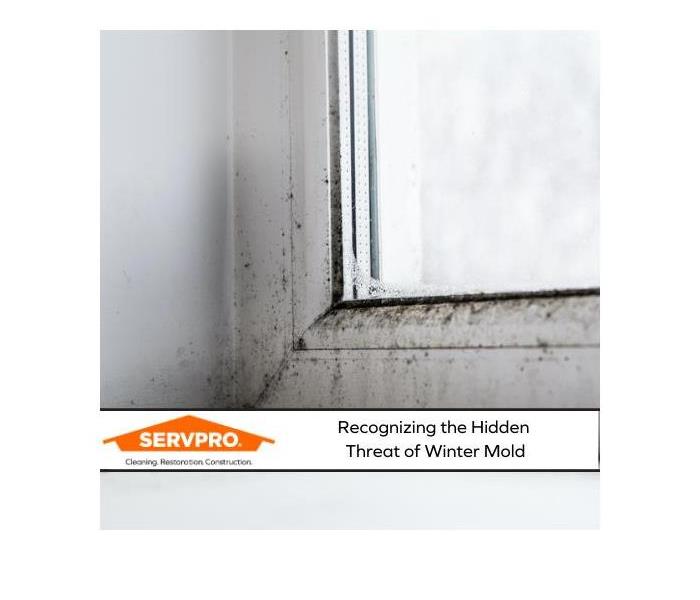 Recognizing the Hidden Threat of Winter Mold: Signs You Shouldn't Ignore
Recognizing the Hidden Threat of Winter Mold: Signs You Shouldn't Ignore
As winter blankets us in frosty mornings and cozy evenings, many of us focus on creating a warm and inviting home. However, the season also brings conditions that can encourage mold growth. While mold is often associated with damp summer months, sealed windows, running heaters, and limited ventilation during winter can create an ideal environment for mold to thrive. Staying informed and vigilant can help protect your home from this hidden threat.
Why Winter Encourages Mold Growth
Mold needs three key elements to grow: moisture, warmth, and poor airflow—all of which are often present in homes during winter. Condensation forms when warm indoor air meets cold surfaces like windows, walls, and pipes. This moisture can go unnoticed and quickly become a breeding ground for mold. Areas like basements, bathrooms, and closets, which often have limited ventilation, are especially vulnerable.
Unique winter challenges, such as ice dams on roofs, also contribute to mold issues. Ice dams form when snow melts on the roof and refreezes near the edges, trapping water behind them. This water can seep into attics and walls, creating hidden pockets of moisture. Additionally, indoor humidity levels may rise from the use of humidifiers, contributing further to mold-friendly conditions.
Signs of Mold in Your Home
Detecting mold early is key to preventing larger problems. Here are common signs to look for:
- Persistent odors: A musty smell in damp or poorly ventilated areas can indicate mold.
- Visible discoloration: Black, green, or white patches on walls, ceilings, or other surfaces are potential signs. Look closely at areas around windows, sinks, and pipes.
- Unexplained stains: Water stains or streaks might hide mold beneath the surface.
Your HVAC system can also play a role in mold issues. If not properly maintained, heating ducts and vents can circulate mold spores, potentially worsening the problem.
Winter-Specific Triggers for Mold Growth
Winter comes with unique conditions that can increase the risk of mold:
- Ice dams: These form when snow melts on a roof and refreezes at the edges, trapping water. The resulting leaks into walls or attics often go unnoticed.
- Frozen or burst pipes: These can release water into hidden spaces, creating ideal conditions for mold.
- Condensation: Moisture collecting on windows, walls, or behind furniture can lead to mold growth over time.
Preventing Mold During Winter
Proactive measures can significantly reduce the risk of mold:
- Control humidity: Maintain indoor humidity levels between 30% and 50% using dehumidifiers if necessary.
- Ensure ventilation: Use exhaust fans in kitchens and bathrooms to reduce moisture.
- Inspect your home: Regularly check for leaks around windows, doors, and roofs, and address them promptly.
- Monitor high-risk areas: Keep an eye on basements, attics, and other spaces prone to dampness.
What to Do if You Spot Mold
Addressing mold quickly is essential to preventing its spread. Here’s how to approach it:
- Identify and fix the moisture source: Whether it’s a leaking pipe, poor insulation, or condensation, resolving the root cause is crucial.
- Clean small patches: Minor mold growth can often be cleaned with appropriate household products.
- Consult professionals: Extensive or hidden mold often requires professional remediation services. Experts can inspect hard-to-reach areas, such as behind walls or inside ducts, and take comprehensive measures to resolve the issue.
Don’t Let Mold Go Unchecked
Mold can pose risks to your home and its structural integrity if left unaddressed. By recognizing the warning signs and taking proactive steps, you can ensure a safe and healthy environment throughout the winter months.
If you suspect mold or want to take preventive measures, reach out to a professional today. Protect your home and enjoy the peace of mind that comes with knowing your space is mold-free.
As winter blankets us in frosty mornings and cozy evenings, many of us focus on creating a warm and inviting home. However, the season also brings conditions that can encourage mold growth. While mold is often associated with damp summer months, sealed windows, running heaters, and limited ventilation during winter can create an ideal environment for mold to thrive. Staying informed and vigilant can help protect your home from this hidden threat.
Why Winter Encourages Mold Growth
Mold needs three key elements to grow: moisture, warmth, and poor airflow—all of which are often present in homes during winter. Condensation forms when warm indoor air meets cold surfaces like windows, walls, and pipes. This moisture can go unnoticed and quickly become a breeding ground for mold. Areas like basements, bathrooms, and closets, which often have limited ventilation, are especially vulnerable.
Unique winter challenges, such as ice dams on roofs, also contribute to mold issues. Ice dams form when snow melts on the roof and refreezes near the edges, trapping water behind them. This water can seep into attics and walls, creating hidden pockets of moisture. Additionally, indoor humidity levels may rise from the use of humidifiers, contributing further to mold-friendly conditions.
Signs of Mold in Your Home
Detecting mold early is key to preventing larger problems. Here are common signs to look for:
- Persistent odors: A musty smell in damp or poorly ventilated areas can indicate mold.
- Visible discoloration: Black, green, or white patches on walls, ceilings, or other surfaces are potential signs. Look closely at areas around windows, sinks, and pipes.
- Unexplained stains: Water stains or streaks might hide mold beneath the surface.
Your HVAC system can also play a role in mold issues. If not properly maintained, heating ducts and vents can circulate mold spores, potentially worsening the problem.
Winter-Specific Triggers for Mold Growth
Winter comes with unique conditions that can increase the risk of mold:
- Ice dams: These form when snow melts on a roof and refreezes at the edges, trapping water. The resulting leaks into walls or attics often go unnoticed.
- Frozen or burst pipes: These can release water into hidden spaces, creating ideal conditions for mold.
- Condensation: Moisture collecting on windows, walls, or behind furniture can lead to mold growth over time.
Preventing Mold During Winter
Proactive measures can significantly reduce the risk of mold:
- Control humidity: Maintain indoor humidity levels between 30% and 50% using dehumidifiers if necessary.
- Ensure ventilation: Use exhaust fans in kitchens and bathrooms to reduce moisture.
- Inspect your home: Regularly check for leaks around windows, doors, and roofs, and address them promptly.
- Monitor high-risk areas: Keep an eye on basements, attics, and other spaces prone to dampness.
What to Do if You Spot Mold
Addressing mold quickly is essential to preventing its spread. Here’s how to approach it:
- Identify and fix the moisture source: Whether it’s a leaking pipe, poor insulation, or condensation, resolving the root cause is crucial.
- Clean small patches: Minor mold growth can often be cleaned with appropriate household products.
- Consult professionals: Extensive or hidden mold often requires professional remediation services. Experts can inspect hard-to-reach areas, such as behind walls or inside ducts, and take comprehensive measures to resolve the issue.
Don’t Let Mold Go Unchecked
Mold can pose risks to your home and its structural integrity if left unaddressed. By recognizing the warning signs and taking proactive steps, you can ensure a safe and healthy environment throughout the winter months.
If you suspect mold or want to take preventive measures, reach out to a professional today. Protect your home and enjoy the peace of mind that comes with knowing your space is mold-free.
Fire Safety Tips for a Safe Thanksgiving Season
11/22/2024 (Permalink)
 Fire Safety Tips for a Safe Thanksgiving Season
Fire Safety Tips for a Safe Thanksgiving Season
The Thanksgiving season is a time to gather with loved ones, share laughter, and enjoy delicious meals around the table. However, the same activities that make this time of year so special can also increase the risk of fire hazards in your home. At SERVPRO®, we want to help you focus on what truly matters—your family, friends, and traditions— while also ensuring your safety.
The Heart of Thanksgiving: Cooking with Care
For many families, the kitchen becomes the heart of the home during Thanksgiving. It’s where the turkey roasts, the pies bake, and the memories are made. But it’s also where the majority of home fires start during this season. Unattended cooking is one of the leading causes of these fires, so it’s important to stay vigilant.
Make it a habit to remain in the kitchen whenever the stove or oven is on. If you’re juggling multiple dishes, enlist a helper to keep an eye on things while you step away. Keep flammable items like dish towels, paper, or wooden utensils far from burners. And while deep-fried turkeys may be a popular tradition, they come with their own set of risks. If you’re planning to fry your turkey, ensure you do it outdoors, on a flat surface, and away from any structures.
Candles and Decorations: Adding Ambiance Without Risk
Candles bring a warm, festive glow to any Thanksgiving table, but they also account for a significant number of home fires during the holiday season. If you’re using candles to set the mood, place them in sturdy holders and away from flammable items like curtains or tablecloths. Never leave them unattended, and always extinguish them before leaving the room.
For an equally cozy and safer alternative, consider using flameless LED candles. They provide the same ambiance without the worry, allowing you to focus on creating joyful memories.
Staying Warm Without Worry
As the cooler weather sets in, fireplaces and space heaters become essential for creating a cozy atmosphere. Before lighting your fireplace, ensure it’s been properly cleaned and inspected for any blockages or creosote buildup. Keep a screen in front of the fire to prevent sparks from escaping, and never leave a fire burning unattended.
For space heaters, follow manufacturer guidelines carefully. Keep them on a flat surface and at least three feet away from anything flammable. Always turn them off before leaving the room or going to bed.
Be Prepared for the Unexpected
No one wants to think about the possibility of a fire during a time of celebration, but having a plan in place can make all the difference. Ensure your smoke alarms are in working order by testing them before the holiday season begins. Have a fire extinguisher easily accessible in the kitchen and educate everyone in your home on how to use it.
If an emergency does occur, having a clear evacuation plan can help everyone remain calm and safe. Practice this plan with your family, especially if children or elderly relatives will be spending Thanksgiving with you.
SERVPRO is Here for You
At SERVPRO, we understand how overwhelming the holiday season can be, especially if the unexpected happens. Should your home experience fire damage, smoke damage, or any other emergency, our team is here to help. We specialize in restoring homes quickly and efficiently so you can get back to enjoying the moments that matter most.
This Thanksgiving, let’s prioritize safety so we can all focus on what truly makes the season special: time spent with the ones we love. From all of us at SERVPRO, we wish you a safe and happy Thanksgiving season.
If you need us, we’re just a call away, 24/7, 365 days a year. Because at SERVPRO, we’re committed to being there for you, "Like it never even happened.”
Understanding Water Damage: Causes, Risks, and How to Respond
10/23/2024 (Permalink)
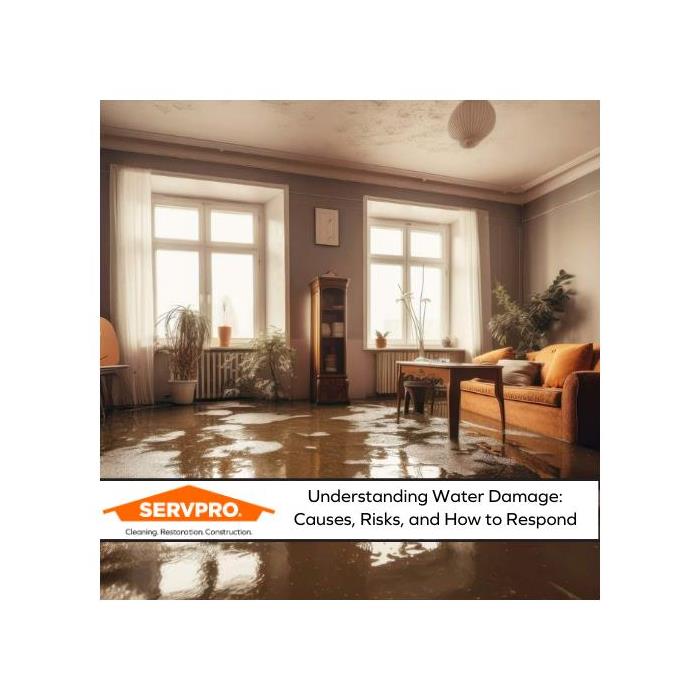 Understanding Water Damage: Causes, Risks, and How to Respond
Understanding Water Damage: Causes, Risks, and How to Respond
Water damage is one of the most common and costly disasters that can affect homes and businesses. Whether it’s from a broken pipe, a natural disaster, or a hidden leak, the impact can be severe if not addressed quickly. At SERVPRO of East Greenville County, we’re committed to helping our community stay informed and prepared to handle water-related emergencies.
What Causes Water Damage?
Water damage can occur due to several reasons, some preventable and others outside our control. Here are some of the most common causes:
Severe Weather – Heavy rainfall, hurricanes, or floods are often the main culprits. When the ground becomes saturated or drainage systems fail, water can easily find its way into homes and businesses.
Plumbing Issues – Burst pipes, faulty appliances, or leaks in water supply lines can cause significant damage if not detected early.
Roof Damage – A damaged or poorly maintained roof can allow water to seep into the attic and cause structural damage or mold growth.
Basement Flooding – Many homes in Greenville County have basements, which can be susceptible to flooding during storms or due to poor drainage systems.
What Affects Flood Risk?
Flood risk is not the same for every property, and several factors influence whether your home or business may be more prone to water damage:
Location and Geography – Properties in low-lying areas or near rivers, creeks, or lakes are more susceptible to flooding. If your property is in a designated floodplain, your risk is naturally higher.
Urbanization and Drainage Systems – As cities expand, water runoff increases, overwhelming drainage systems and increasing flood risks.
Soil and Ground Saturation – After heavy rainfall, soil may become saturated, unable to absorb additional water, leading to flooding.
The Costly Consequences of Water Damage
Water damage is not just an inconvenience—it can lead to lasting structural damage, mold growth, and loss of personal property. Within hours, water can warp wood, cause drywall to
deteriorate, and create an environment ripe for mold to develop. Over time, this can compromise the integrity of your home or business.
What You Should Do When Water Damage Occurs
If you experience water damage, immediate action is critical to minimizing further damage. Here’s a step-by-step guide:
Safety First – Ensure that the affected area is safe to enter. If water has reached electrical outlets or appliances, turn off the power to avoid electrocution.
Stop the Water Source – If the damage is caused by a plumbing issue, shut off the main water supply to prevent further flooding.
Document the Damage – Take photos or videos of the damage for your insurance claims.
Contact SERVPRO of East Greenville County – Our team is equipped to handle water damage restoration 24/7. We have the tools and expertise to quickly extract water, dry out the affected areas, and restore your property to its pre-damage condition.
How SERVPRO Can Help
At SERVPRO of East Greenville County, we specialize in water damage restoration. Our certified professionals are trained to handle everything from minor leaks to major flooding incidents. Using advanced equipment and techniques, we will:
Inspect and Assess the water damage.
Extract Water using industrial pumps and vacuums.
Dry and Dehumidify the affected areas.
Clean and Sanitize to remove contaminants.
Restore your property to its original condition.
Why Choose SERVPRO of East Greenville County?
When disaster strikes, trust the professionals at SERVPRO of East Greenville County. With our experience, cutting-edge equipment, and dedication to excellent service, we will guide you through the process of restoring your property with care and expertise. Whether you’re dealing with water damage, fire, or mold, we’re here to help 24/7.
If you’ve experienced water damage and need assistance, contact us today to get started on the path to recovery.
National Preparedness Month: How to Prepare for the Unexpected
9/24/2024 (Permalink)
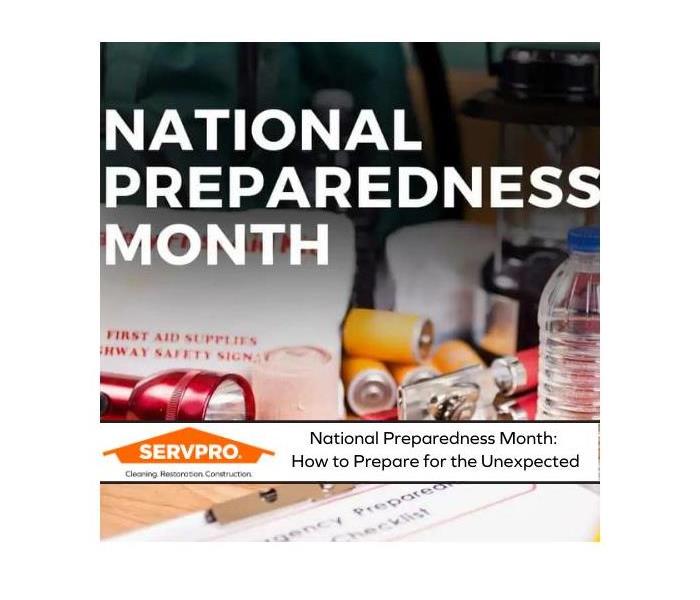 National Preparedness Month: How to Prepare for the Unexpected
National Preparedness Month: How to Prepare for the Unexpected
Every September, FEMA designates National Preparedness Month as a time to focus on building and reviewing your emergency plans. While disasters can happen anytime, this month reminds us of the importance of taking proactive steps to protect our families, homes, and businesses from unexpected crises. As SERVPRO of East Greenville, we understand first hand the devastation disasters can cause and the difference that preparedness makes in reducing long-term damage.
But preparedness isn’t just about having a first aid kit. It’s about creating comprehensive, actionable plans that ensure safety during and after disasters, whether they’re natural, man- made, or health-related. This year, as we observe National Preparedness Month, we encourage you to take stock of your family’s or business’s emergency plans to ensure you’re ready to act when disaster strikes.
The Importance of Preparedness:
Being prepared for a disaster is crucial, whether you’re safeguarding your home or keeping your business operational. Statistics from FEMA show that 40% of companies do not reopen after a disaster, and even fewer businesses have an emergency plan in place. The same concept applies to families: having an emergency plan is not only about survival but also about managing the aftermath in the most efficient way possible.
Preparedness also provides a psychological advantage. Families and businesses with concrete emergency plans tend to recover faster because they’ve mitigated risks in advance. This not only saves time and money but also reduces stress and fear when faced with the unknown.
Types of Disasters to Prepare For:
Disasters come in many forms, from severe weather events to unforeseen man-made hazards.
While each region faces different threats, the Upstate of South Carolina, including Greenville, has its own set of potential disasters.
• Natural Disasters: Hurricanes, tornadoes, floods, wildfires, and earthquakes are all threats. Although we may not face hurricanes directly, the effects of such storms, like heavy flooding, can severely impact the region. Flash floods in Greenville or nearby areas can cause significant property damage.
• Man-Made Disasters: Fires, chemical spills, and power outages are common risks. Electrical fires or industrial accidents can disrupt communities and businesses without warning.
• Pandemics: While not traditionally discussed in disaster planning, health emergencies such as pandemics, as seen with COVID-19, must be considered. These types of disasters affect both families and businesses, requiring special attention to health and wellness preparedness.
Key Elements of an Emergency Plan:
Developing an emergency plan involves much more than having a few supplies. It's about ensuring that your family or business has clear, step-by-step instructions for how to act when faced with different types of emergencies. A solid plan reduces confusion, speeds up response time, and can help minimize damage. Whether you're preparing for a flood, fire, or another type of disaster, here are the essential components to include:
• Communication Plan: Knowing how to reach your loved ones or employees during an emergency is critical. Designate a central contact person who lives outside the disaster area and ensure all parties know how to communicate through text, email, or phone.
• Evacuation Routes: Whether you’re at home or at your business, identify multiple evacuation routes. This is particularly important for homes or offices in flood-prone areas or near forests prone to wildfires.
• Disaster Kit: Every household or business should have a well-stocked disaster kit. This should include water, non-perishable food, medications, first-aid supplies, flashlights, batteries, and power backups. For businesses, this may also include critical records and data backups stored off-site or in the cloud.
• Shelter Plans: Depending on the disaster, you may need to shelter in place. Ensure you have supplies that will last at least 72 hours and understand the different types of shelter plans, whether staying at home or heading to a designated safe location.
• Disaster Preparation Tips:
For both families and businesses, preparation starts long before disaster strikes. Here are some practical steps to take today:
• For Families: Teach children how to dial emergency numbers, where to go during different types of disasters (e.g., tornadoes, floods), and ensure that important family documents are easily accessible and protected. Simple tasks like securing loose items outside can prevent damage during storms.
• For Businesses: Consider conducting an annual disaster drill with employees. Evaluate your insurance policies to ensure they cover all potential disasters. Also, review your business continuity plan, ensuring you have backup systems for power and data in place. SERVPRO of East Greenville can assist in creating a business emergency plan to reduce downtime and loss.
Managing the Aftermath of a Disaster:
The first 24 hours after a disaster are critical. Immediate action will determine the extent of the long-term damage and how quickly you can recover.
• For Families: Focus on safety first. Once the immediate threat is gone, assess the damage, ensure your loved ones are safe, and reach out to emergency services if needed.
• For Businesses: Business recovery is crucial in reducing financial losses. Securing the property, retrieving important data, and communicating with employees and customers are all key steps to getting back on track. This is where SERVPRO® steps in with restoration services, including fire damage cleanup, water damage restoration, mold remediation, and more.
SERVPRO’s Emergency Ready Profile (ERP):
For businesses in the Greenville area, SERVPRO of East Greenville offers an Emergency Ready Profile (ERP). This comprehensive plan helps businesses minimize downtime after a disaster by preparing ahead of time. The ERP includes critical information such as emergency contacts, utility shut-off locations, and insurance details. Having this profile in place means businesses can act quickly to reduce damage and restore operations.
National Preparedness Month serves as a crucial reminder of the importance of being prepared for the unexpected. Whether you're protecting your family or your business, taking the time to plan now can save lives, reduce damage, and ensure a faster recovery. SERVPRO of East Greenville is Here to Help® you through the process, offering expert advice and emergency services when you need them most.
This September, take action. Review your emergency plans, create a disaster kit, and let SERVPRO of East Greenville guide you in protecting what matters most.
Understanding Mold: A Guide for Home and Business Owners
8/23/2024 (Permalink)
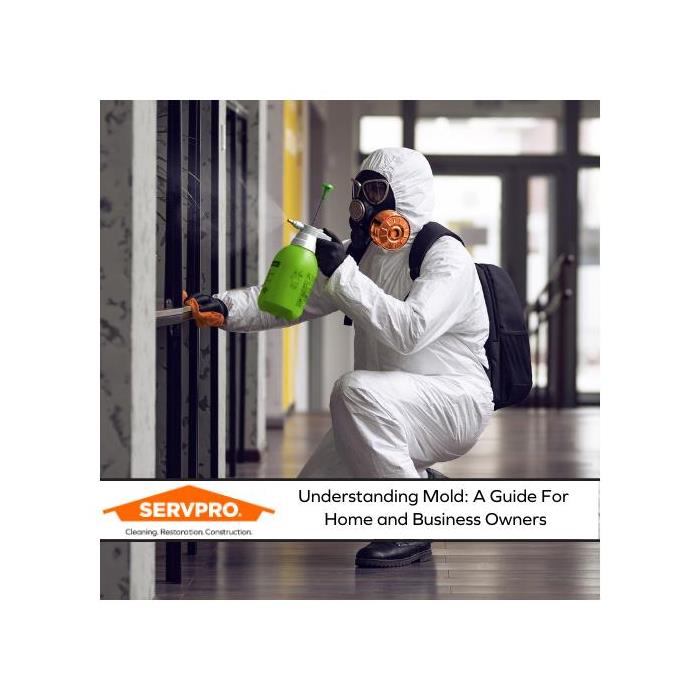 Mold Mitigation
Mold Mitigation
Mold is an ever-present part of our environment. While it plays an essential role outdoors, mold can cause significant problems when it invades our homes or businesses. Understanding how mold spreads, why it grows, and how to handle it is crucial to maintaining a safe and healthy indoor environment. In this blog, we'll explore what mold is, dispel common myths, and detail how SERVPRO of East Greenville can help with mold remediation.
The Nature of Mold: Why It's Everywhere
Mold spores are tiny, almost invisible to the naked eye, and found virtually everywhere. Whether you’re inside your home, at your business, or outdoors, mold spores are in the air. These spores can easily enter buildings through windows, doors, HVAC systems, or by hitching a ride on clothing or pets. Because of their ubiquity, completely removing mold from an indoor environment is impossible. This is why mold remediation, rather than removal, is the appropriate approach.
Mold Remediation vs. Mold Removal: The Reality
You may have seen companies advertising “mold removal” services that claim to eliminate all mold from a property. However, this is misleading. Given that mold naturally exists indoors and outdoors, it is impossible to remove all mold from any environment. The goal of mold remediation is to reduce mold spore counts to natural, safe levels, addressing the underlying moisture issue to prevent future growth.
Mold remediation involves multiple steps, including inspection, containment, air filtration, removal, cleaning, and restoration. SERVPRO of East Greenville follows these steps meticulously to ensure that mold is effectively managed.
Key Facts About Mold
Understanding mold is the first step to protecting your property. Here are some key points:
- Mold is natural: Mold spores exist everywhere, both indoors and outdoors.
- Mold thrives on moisture: Mold spores need moisture to grow. When exposed to water, mold spores can quickly develop into colonies that produce allergens and irritants.
- Moisture control is essential: Addressing the source of moisture is critical before beginning mold remediation; otherwise, mold is likely to return.
- Mold is often identified by its odor: A strong, musty smell can indicate the presence of mold in your property.
- Humidity encourages mold growth: Maintaining indoor humidity below 45% is essential to prevent mold growth.
The Mold Remediation Process: SERVPRO's Approach
When mold is discovered, it's important to act quickly to prevent it from spreading. Here’s how SERVPRO of East Greenville manages mold remediation:
- Emergency Contact: The process begins when you contact SERVPRO®. Our specialists gather information to determine the necessary resources and personnel for your situation.
- Inspection and Mold Damage Assessment: Our team conducts a thorough inspection of your property to identify visible signs of mold and locate hidden moisture sources that could contribute to further growth.
- Mold Containment: Containment procedures, such as negative air chambers and physical barriers, are used to prevent the spread of mold during remediation. We also turn off HVAC systems to avoid spreading spores.
- Air Filtration: Using advanced filtration equipment, including HEPA vacuums, we capture microscopic mold spores from the air. This step is critical to improving air quality and preventing further contamination.
- Removing Mold and Mold-Infested Materials: Depending on the extent of the infestation, mold-infested porous materials like drywall, carpeting, and insulation may need to be removed. Anti-fungal and antimicrobial treatments are applied to prevent new colonies from forming.
- Cleaning: Our professionals clean and sanitize affected areas and belongings, including furniture, curtains, and personal items. We also use specialized techniques to deodorize your property.
- Restoration: After remediation, we restore your property to its pre-mold condition. This may involve minor repairs like replacing drywall, painting, and installing new carpet, or more extensive reconstruction, depending on the damage.
Preventing Future Mold Growth
While mold is a natural part of our environment, there are steps you can take to minimize its presence in your home or business:
- Control Humidity: Use dehumidifiers and air conditioners to keep indoor humidity levels below 45%.
- Fix Leaks Promptly: Repair any leaks in your roof, walls, or plumbing immediately to prevent moisture accumulation.
- Ensure Proper Ventilation: Keep your property well-ventilated, particularly in moisture-prone areas like bathrooms, kitchens, and basements.
- Use Mold-Resistant Products: Consider using mold-resistant drywall, insulation, and paints during renovations or construction.
Mold can be a daunting issue, but with the right knowledge and professional help, it can be effectively managed. At SERVPRO of East Greenville, we understand the complexities of mold and offer comprehensive remediation services to protect your property and your health. Our team of experts is equipped with the training, tools, and techniques necessary to handle any mold issue, regardless of size.
If you suspect mold in your home or business, don’t wait. Contact SERVPRO of East Greenville today to schedule an inspection and let us help you restore your property to a safe, mold-free environment.
Essential Storm Safety Kit: What to Pack in Your Emergency Kit
6/19/2024 (Permalink)
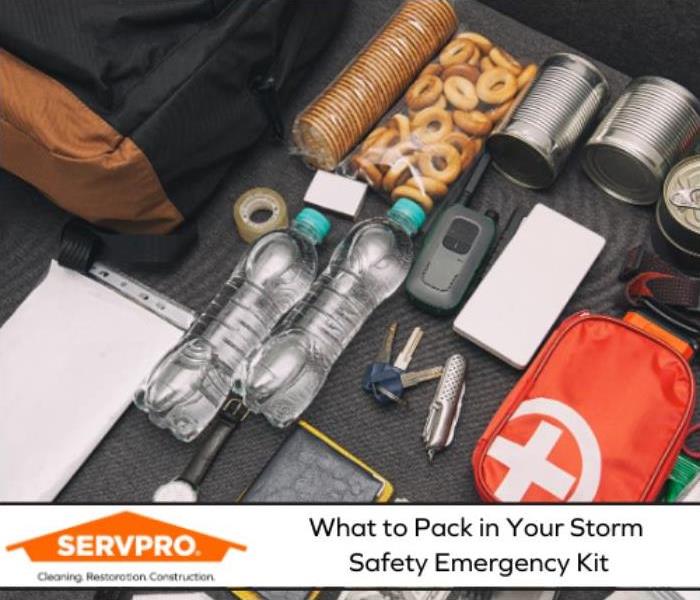 Items to pack in your storm emergency kit.
Items to pack in your storm emergency kit.
Storms can strike with little warning, leaving behind significant storm damage and potential hazards for your home and family. Being prepared with a well-stocked storm safety kit is crucial for ensuring your safety and minimizing damage during these emergencies. In this guide, we will explore the essential components of a storm safety kit including tools, supplies, and communication devices. From flashlights and first aid kits to generators and hygiene essentials, ensure your home is protected and your family is safe during emergencies.
A storm safety kit is more than just a collection of items; it's a lifeline that makes sure you have what you need when normal supplies and services are disrupted. As storms can cause power outages, flooding, and even force you to evacuate your home, being prepared with the right tools and supplies can make a significant difference. Let's look into the key components of an effective storm safety kit.
Essential Tools and Supplies
- Flashlights and Batteries: Power outages are common during storms, so ensure you have several reliable flashlights and an ample supply of batteries. Having a backup set of batteries is crucial since you might not have access to new ones for an extended period.
- Multi-Tool or Swiss Army Knife: A versatile multi-tool can be invaluable in emergency situations, providing you with tools like pliers, screwdrivers, and a knife. This can help with everything from cutting through debris to making quick repairs around the house.
- Manual Can Opener: In the event of a power outage, a manual can opener will allow you to access your canned food supplies.
- Duct Tape: Duct Tape can be used for quick repairs, sealing leaks, and securing items. Its strong adhesive properties make it ideal for temporary fixes in a variety of situations.
- Plastic Sheeting and Tarps: These can be used to cover damaged areas, prevent further water intrusion, and create makeshift shelters if needed. They can also be laid on the ground to keep your living area dry if your home is compromised.
- Sandbags: If you live in a flood-prone area, having sandbags ready can help divert water away from your home and prevent storm damage. Properly placed sandbags can be an effective barrier against rising water levels.
First Aid Kit
- Basic Medical Supplies: Bandages, gauze, antiseptic wipes, adhesive tape, scissors, tweezers, and a digital thermometer. These items can help address minor injuries and prevent infections.
- Medications: Include a supply of any prescription medications your family members need, as well as over-the-counter pain relievers, anti-inflammatory drugs, and antihistamines. Having a few days' worth of medication ensures that medical needs are met even if access to pharmacies is limited.
- First Aid Manual: A first aid manual or guide can be extremely helpful for addressing injuries and medical issues during a crisis. Knowing how to properly treat wounds, burns, and other injuries can make a big difference in an emergency.
Communication Devices
- Battery-Powered or Hand-Crank Radio: A weather radio can keep you informed about storm updates, emergency alerts, and evacuation orders. Choose a model with multiple power options, including battery and hand-crank.
- Cell Phone and Charger: Ensure your cell phone is fully charged before the storm hits and include a portable charger or power bank in your kit. A fully charged phone is essential for staying in touch with family, friends, and emergency services.
- Whistle: A whistle can be used to signal for help if you are trapped or need assistance. Its sound can carry much further than a voice, making it an effective tool for attracting attention.
Food and Water Supplies
- Non-Perishable Food: Canned goods, dried fruits, nuts, energy bars, and other non-perishable food items that require minimal preparation. Foods with long shelf lives and high caloric content are ideal for maintaining energy levels.
- Water: Store at least one gallon of water per person per day for at least three days. This water should be used for drinking and sanitation purposes. In addition to bottled water, consider water purification tablets or a portable water filter in case your supply runs out.
Hygiene and Sanitation
- Hygiene Essentials: Soap, hand sanitizer, toothbrushes, toothpaste, and feminine hygiene products. Keeping clean helps prevent the spread of bacteria and viruses.
- Sanitation Supplies: Garbage bags, plastic ties, and a portable toilet or bucket for waste disposal. These items help manage waste when regular plumbing is unavailable.
Shelter and Warmth
- Blankets and Sleeping Bags: Pack enough blankets and sleeping bags to keep your family warm in cold weather. Choose items that are lightweight and compact for easy transport.
- Emergency Blankets: These lightweight, space-saving blankets are designed to retain body heat and can be a lifesaver in cold conditions. They are also waterproof and windproof.
- Tent or Shelter: A small tent or portable shelter can provide temporary protection if you need to leave your home. It can also serve as a designated sleeping area within your home if it’s damaged.
Important Documents and Cash
- Important Documents: Store copies of important documents in a waterproof container. These should include identification, insurance policies, medical records, and bank account information. Having these documents accessible ensures you can quickly start the recovery process.
- Cash: In the event of power outages, ATMs and card readers may not be functional, so having cash on hand can be crucial for purchasing necessary supplies. Small denominations are ideal for making transactions easier.
Being prepared with a well-stocked storm safety kit can make all the difference when a storm strikes. By including essential tools, supplies, communication devices, and other critical items, you can ensure your home is protected and your family is safe during emergencies. Remember, the key to effective emergency preparedness is planning ahead and regularly updating your kit to meet your family's evolving needs. Stay safe and be prepared!
For more information on storm damage preparedness and recovery, contact SERVPRO of East Greenville County. Our professionals are ready to help you protect your home and respond quickly to any storm damage.
Preparing for Winter Storm in Greer, SC
11/17/2023 (Permalink)
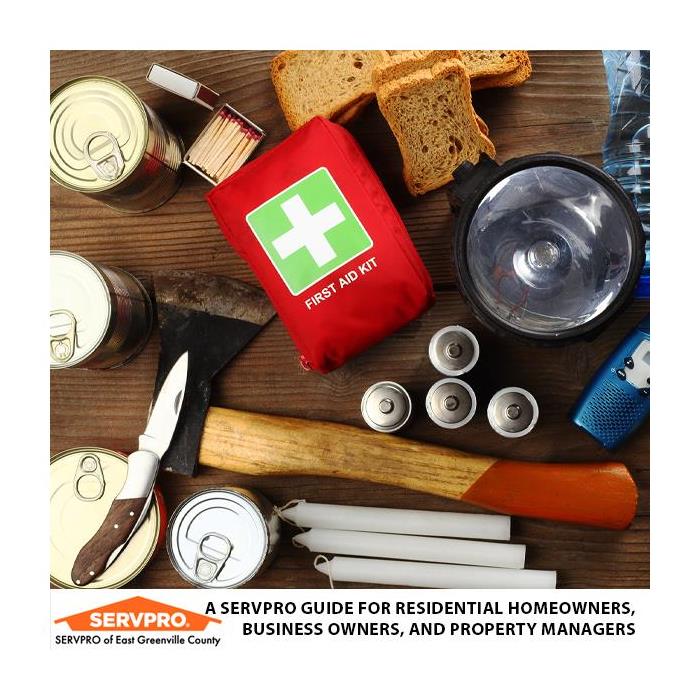 Preparing for Winter Storm | A SERVPRO Guide for Residential Homeowners, Business Owners, and Property Managers.
Preparing for Winter Storm | A SERVPRO Guide for Residential Homeowners, Business Owners, and Property Managers.
A SERVPRO® Guide for Residential Homeowners, Business Owners, and Property Managers
With winter quickly approaching, there is a high possibility of heightened storm activity. So now is a good time to prepare as a resident or property owner in East Greenville which includes Greer, SC. It is important to be proactive and take measures to safeguard your property and assets from the damaging effects of winter storms. In addition to reducing anxiety and ensuring you are ready to handle any emergency that may arise, being well-prepared can help protect your assets. In this article, we will provide you with a comprehensive guide on how to prepare for winter storms in Greer, SC.
Create a winter emergency kit: Having a winter emergency kit on hand is one of the best first steps to prepare for a winter storm. Be sure your kit contains items such as a first-aid kit, a flashlight, blankets, a portable radio, and non-perishable food such as canned goods and snacks. A backup power source such as a generator is an investment worth making, just in case of power outages.
Insulate your property: Winter storms often lead to frozen pipes and water damage. To avoid this, ensure that pipes and outdoor fixtures are well-insulated. Consider covering hose outlets with this protector (Amazon Link). These will not only help to prevent frozen pipes but will also help to reduce energy bills by keeping your property well heated. Do a visual check of all weatherstrip doors and windows to prevent drafts and retain warm indoor air.
Trim trees and clear gutters: Southern winter storms can produce heavy snowfall, strong winds that can cause tree branches to fall, causing damage to your property. Simply, trimming your tree branches, so they don't hang in critical areas, can be a game changer. Clearing your gutters of fallen leaves and asphalt granules, will also help to prevent water from seeping into your roof and causing damage.
Secure loose outdoor items: Winter storms will often cause debris to fly around. It is a good idea to secure outdoor items like patio furniture, planters, and grill covers. It would be a good idea to store them in a secure location, like a storage unit. Or tie them together or down to prevent them from getting carried away by strong winds.
Have SERVPRO, a restoration and cleaning professional on standby: Add SERVPRO of East Greenville County's phone number, (864) 292-3495 to your cell phone. In the event of damage to your property caused by a winter storm, SERVPRO of East Greenville County, is on standby. We can assess the damage to your property and provide the necessary services such as water damage restoration or mold removal. SERVPRO restoration and cleaning professionals have the expertise and equipment required to handle any storm damage.
Winter storms can be devastating, but being well-prepared can help reduce the impact. Creating an emergency kit, insulating your property, clearing gutters, trimming tree branches, securing loose outdoor items, and having a restoration and cleaning professional on standby are all effective measures to prepare for winter storms. Take these preventative measures, and you'll be well on your way to protecting your property from winter storms. With the right preparation, you can keep your home or business safe and secure this winter season.
Be sure to find and follow us on all or your favorite Social Media.
Facebook | LinkedIn | Instagram
Our Class is a Family
10/5/2023 (Permalink)
 Mrs. Evatt's class showing off their new books, purchased by SERVPRO® of East Greenville County.
Mrs. Evatt's class showing off their new books, purchased by SERVPRO® of East Greenville County.
Exciting news, everyone! SERVPRO® of East Greenville County is thrilled to team up with our amazing local schools to support education. We recently had the wonderful opportunity to donate a bunch of awesome books to Mrs. Evatt's class at Fairforest Elementary School. And guess what? The chosen book, "Our Class is a Family," is perfect for kicking off the kindergarten year with a bang! Let's embrace the joy of learning together!
Investing in the next generation is key to any communities growth. Nothing is more important than getting involved with our youth and their education and future. We are thankful for teachers like Mrs. Evatt for pouring into her students.
#SERVPRO #SERVPROofeastgreenvillecounty #stormdamage #WaterDamage #disasterrelief #moldremediation #fastertoanysizedisaster #carpetcleaning #EmergencyReadyProgram #ERP #winddamage #haildamage #pipeburst #fairforestelementaryschool #inthecommunity #supportlocalschools
Greenville Community Ministries
10/5/2023 (Permalink)
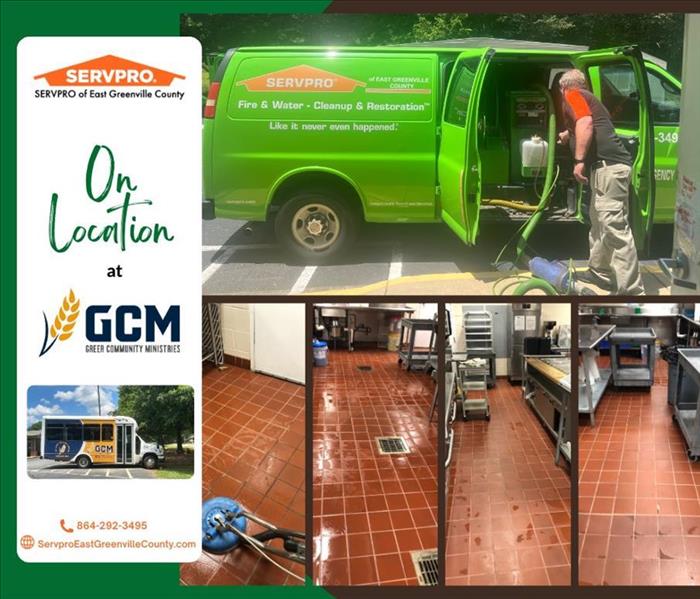 SERVPRO® of East Greenville County shinning up the kitchen floor for Greer Community Ministries and Meals on Wheels.
SERVPRO® of East Greenville County shinning up the kitchen floor for Greer Community Ministries and Meals on Wheels.
SERVPRO® of East Greenville County had the privilege of assisting the Greater Greer community. We were grateful for the opportunity to clean the kitchen tile, which is used for Meals on Wheels and Senior Dining at Greer Community Ministries. Greer Community Ministries assists in providing food, clothing, and meaningful social interaction to those in need. They offer four programs: Meals on Wheels, Senior Dining, Food Pantry, and Sharon’s Closet. Take a look at the pictures of both the SERVPRO van and the Greer Community Ministries van, both of which play a vital role in supporting our community.
Our Community Liaison, Johnathan Evatt, recently spent sometime with James Abbott with Greer Community Ministries. James and his team are dedicated to the less fortunate in our Greer community and go the extra mile to see that they are well loved and cared for.
#SERVPRO #SERVPROofeastgreenvillecounty #stormdamage #WaterDamage #disasterrelief #moldremediation #fastertoanysizedisaster #GreerCommunityMinistries #GreerCommunity #MealsonWheels #SharonsCloset #foodpantry






 24/7 Emergency Service
24/7 Emergency Service









